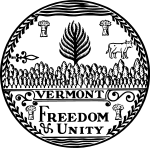| |||||||||||||||||
| |||||||||||||||||
 County results Bell: 50–60% 60–70% 70–80% 80–90% | |||||||||||||||||
| |||||||||||||||||
| Elections in Vermont |
|---|
 |
The 1904 Vermont gubernatorial election took place on September 6, 1904. Incumbent Republican John G. McCullough, per the "Mountain Rule", [1] did not run for re-election to a second term as Governor of Vermont. Republican candidate Charles J. Bell defeated Democratic candidate Eli H. Porter to succeed him.

